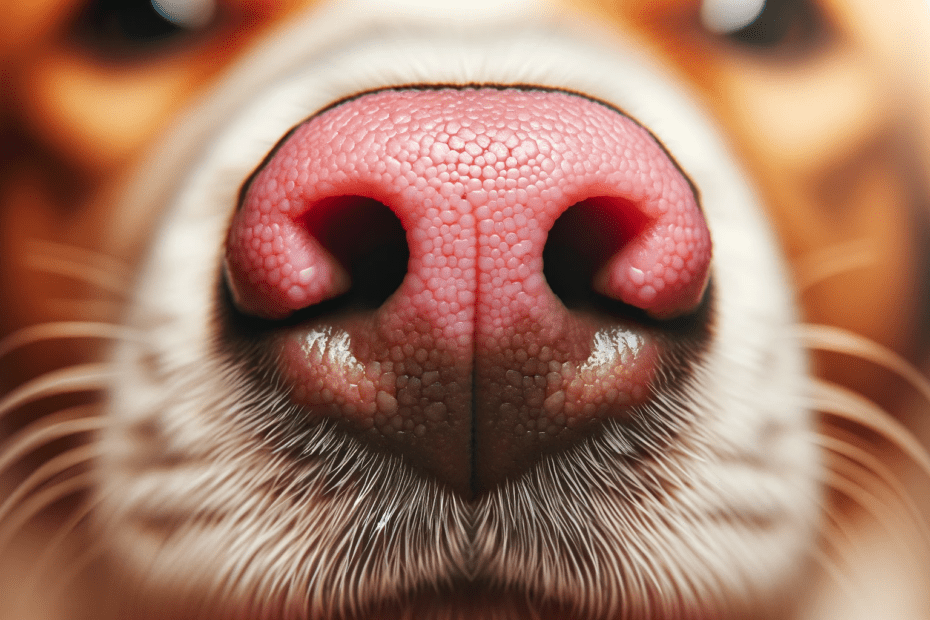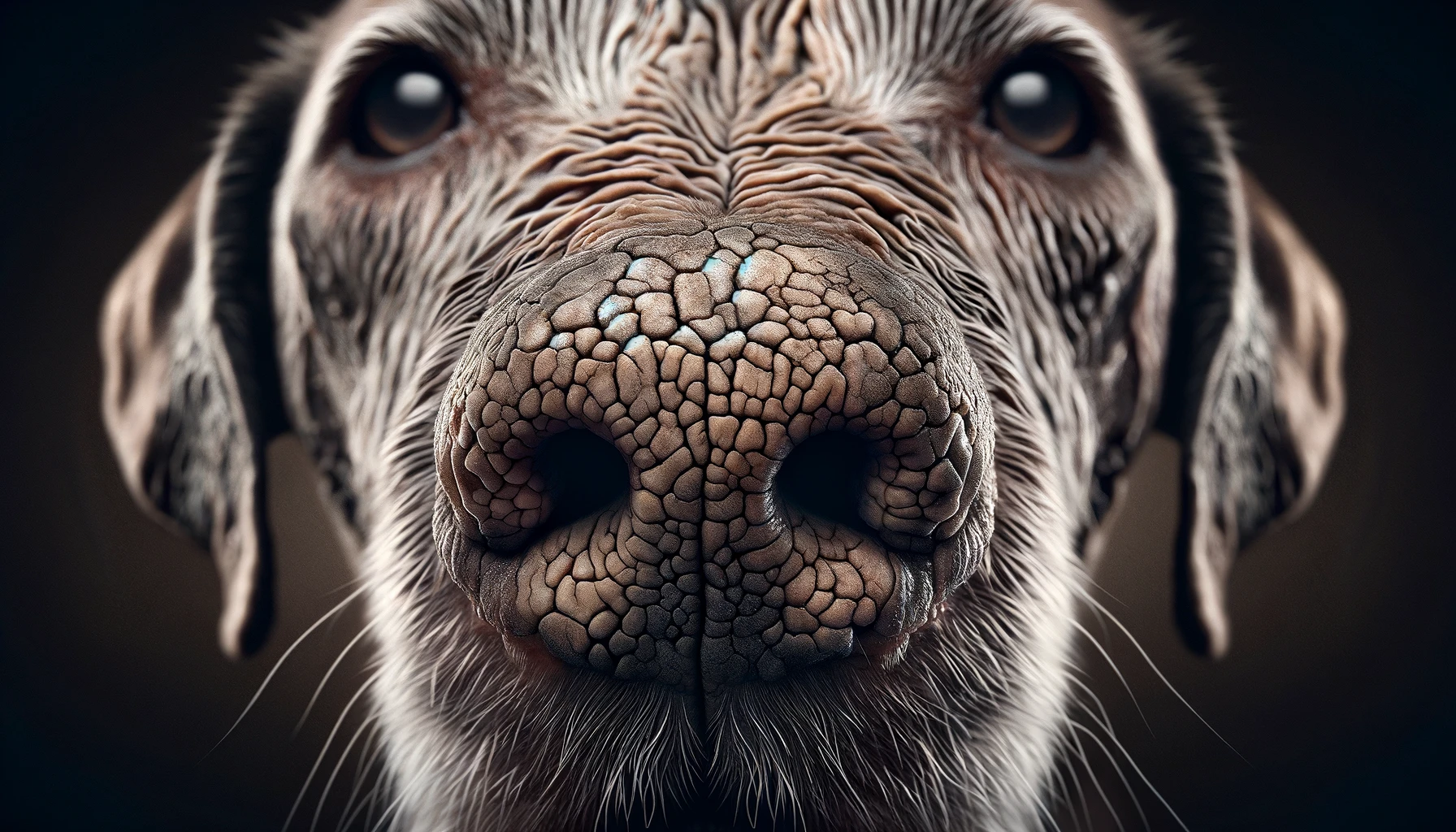The pigmentation of a dog’s nose is a topic of interest for many pet owners. Understanding why a dog’s nose may turn pink requires a scientific approach.
This article delves into the factors influencing nose color in dogs, such as melanin production, pigmentation changes, environmental influences, allergies, sunburn, health conditions, and age.
By exploring these factors, pet owners can gain insight into how to maintain a healthy nose color for their furry companions.
Key Takeaways
- Melanin deficiency or pigmentation changes can cause a dog’s nose to turn pink.
- Allergies and irritations can also lead to a pink nose in dogs.
- Proper management of allergies and irritations, including identifying triggers and seeking veterinary care, is important for nose health.
- Excessive sun exposure can cause sunburn and pinkness on a dog’s nose, so measures like limiting sun exposure and using pet-friendly sunscreen are crucial for preventing nose pinkness.
Melanin and Nose Color
Melanin, a pigment responsible for determining the color of the nose, plays a crucial role in the pink hue that dogs’ noses can develop. The presence or absence of melanin is influenced by genetic factors. Melanin is produced by specialized cells called melanocytes, which are located in the skin, hair follicles, and other parts of the body. The amount and distribution of melanin determine the coloration of various tissues, including the nose.
In some cases, dogs may have a melanin deficiency, resulting in a pink nose. This condition, known as ‘dudley nose’ or ‘snow nose,’ is characterized by a temporary or permanent loss of pigmentation in the nose. Genetic factors contribute to this condition, as certain breeds are more prone to developing a pink nose. Labrador Retrievers, Golden Retrievers, and Siberian Huskies are among the breeds commonly affected.
The exact mechanism behind melanin deficiency in dogs’ noses is not fully understood. However, it is believed to be influenced by a combination of genetic factors. Mutations in genes involved in melanin production or regulation may interfere with the normal pigmentation process, leading to a pink nose. Further research is needed to elucidate the specific genetic mechanisms involved in melanin deficiency in dogs’ noses.
Understanding the role of melanin and the genetic factors influencing nose color in dogs is essential for both breeders and pet owners. It allows for a better understanding of the genetic basis of nose pigmentation and can aid in identifying and managing melanin-related disorders in dogs.
Pigmentation Changes in Dogs
Pigmentation changes in dogs can manifest as a gradual or sudden alteration in the color of their noses. These changes are often attributed to melanin deficiency, which is responsible for the coloration of various tissues in the body, including the skin, hair, and eyes. Melanin is produced by specialized cells called melanocytes, which are primarily found in the skin and hair follicles. In the case of nose pigmentation, a decrease in melanin production can result in a fading or lightening of the nose color, eventually turning it pink.
The exact causes of melanin deficiency in dogs are not fully understood, but genetic factors are believed to play a significant role. Certain breeds, such as the Doberman Pinscher and the Dalmatian, are more prone to experiencing pigmentation changes in their noses. This suggests that specific genes or mutations may be responsible for regulating melanin production in these breeds. Additionally, other factors such as age, hormonal imbalances, and exposure to certain environmental conditions may also contribute to pigmentation changes in dogs.
Understanding the underlying mechanisms behind pigmentation changes in dogs is essential for proper diagnosis and treatment. While a pink nose may not necessarily indicate a health concern, it is always recommended to consult with a veterinarian to rule out any underlying conditions and ensure the well-being of our canine companions.
Environmental Factors Affecting Nose Color
Changes in nose color in dogs can also be influenced by various environmental factors. While pigmentation disorders and genetic factors play a significant role in nose color changes, the environment can also contribute to these alterations. Exposure to sunlight, temperature changes, and certain chemicals can all affect the pigmentation of a dog’s nose.
One environmental factor that can influence nose color is sunlight. Ultraviolet (UV) radiation from the sun can cause the melanin-producing cells in the nose to produce more pigment, resulting in a darker color. On the other hand, prolonged exposure to the sun can also lead to sunburn and skin damage, causing the nose to peel and appear lighter or pinker.
Temperature changes can also impact nose color. Cold weather can cause vasoconstriction, narrowing the blood vessels in the nose and making it appear paler. Conversely, warm weather can result in vasodilation, expanding the blood vessels and causing the nose to appear redder or darker.
Chemicals in the environment can also affect nose color. Certain cleaning products, pesticides, or even medications can cause irritation or allergic reactions, leading to inflammation and changes in pigmentation.
It is important to consider these environmental factors when assessing changes in nose color in dogs. By understanding their influence, veterinarians and pet owners can better diagnose and manage pigmentation disorders in dogs.
Allergies and Irritations
Allergies and irritations can have a significant impact on the color of a dog’s nose. Common allergy triggers such as pollen, dust mites, and certain foods can cause the nose to turn pink.
Additionally, dogs may experience symptoms such as itching, swelling, and discharge in response to these allergens. It is important for pet owners to manage nose irritations by identifying and eliminating potential triggers, seeking veterinary care, and providing appropriate treatment to alleviate discomfort.
Common Allergy Triggers
Many dogs are affected by a variety of common allergy triggers, leading to nose discoloration and irritations.
Allergies in dogs can be caused by a wide range of substances, including pollen, dust mites, mold spores, certain foods, and insect bites. These allergens can cause the dog’s immune system to overreact, resulting in a release of histamines that cause inflammation and irritation.
When the nose is exposed to these allergens, it can become pink or red, and the dog may experience itching, sneezing, and nasal discharge.
Managing nose irritations caused by allergies involves identifying and avoiding the triggers, providing a clean and allergen-free living environment, using antihistamines or other prescribed medications, and in severe cases, immunotherapy may be recommended to desensitize the dog’s immune system.
Symptoms and Reactions
One common symptom of allergies and irritations in dogs is a pink or red nose, accompanied by itching, sneezing, and nasal discharge. When a dog is exposed to allergens such as pollen, dust mites, or certain foods, their immune system can overreact, leading to these symptoms.
Allergies can also cause skin irritation, resulting in a pink or reddened nose. To manage these symptoms, veterinary guidance is crucial. Antihistamines or corticosteroids may be prescribed to alleviate the itching and reduce inflammation. In cases of severe allergies, immunotherapy may be recommended.
Additionally, sunburn prevention is important as dogs with a pink nose are more susceptible to UV damage. Applying pet-safe sunscreen or providing shade can help protect their sensitive skin from harmful UV rays.
Proper management of symptoms and preventive measures can ensure a comfortable and healthy life for dogs with allergies and irritations.
Managing Nose Irritations
To effectively manage nose irritations, it is essential to address the underlying causes of allergies and irritations in dogs. Allergies can be triggered by various factors such as pollen, dust mites, certain foods, or even certain materials.
In order to manage allergies, it is important to identify the specific allergen and minimize exposure to it. This can be achieved by keeping the dog’s environment clean, using hypoallergenic bedding, and avoiding potential triggers.
Additionally, regular nose care is crucial to prevent and manage irritations. Cleaning the dog’s nose with a damp cloth or using a saline solution can help remove any allergens or irritants present.
It is also recommended to consult with a veterinarian for proper diagnosis and treatment options. By effectively managing allergies and following proper nose care tips, dog owners can help alleviate nose irritations and promote a healthier nasal environment for their pets.
Sunburn and Nose Pinkness
Excessive exposure to the sun can have adverse effects on a dog’s nose, leading to pinkness. The sun’s ultraviolet (UV) rays can cause sunburn, which in turn can result in the nose turning pink.
The lack of protective pigmentation in certain breeds can also contribute to the increased vulnerability of their noses to sunburn.
To prevent sunburn in dogs, it is important to limit their time in direct sunlight, provide shade, and use pet-friendly sunscreens specifically formulated for dogs.
Sun’s Effect on Nose
The sun’s rays can cause sunburn and result in a pink hue on a dog’s nose. Dogs, like humans, can be susceptible to the harmful effects of ultraviolet (UV) rays. When a dog’s nose is exposed to excessive sunlight, the skin can become damaged and inflamed, leading to sunburn. Sunburn on a dog’s nose is characterized by redness, swelling, and discomfort.
Furthermore, prolonged exposure to the sun can also affect the pigmentation of a dog’s nose. UV rays can cause the nose to lose its natural color and appear pink. To protect dogs from sunburn and nose pigmentation issues, it is essential to provide them with shade, limit their time in direct sunlight, and consider using sunscreen specifically formulated for dogs.
Applying sunscreen to a dog’s nose can help prevent sunburn and maintain the natural pigmentation of their nose.
Causes of Pinkness
One possible cause of pinkness in a dog’s nose is sunburn. This can result from exposure to harmful UV rays, which can be particularly damaging to dogs with lighter skin and less melanin. Melanin is a pigment that gives color to the skin, hair, and eyes, acting as a natural sunscreen. Dogs with lower melanin levels have less protection, making them more prone to sunburn and pinkness on their noses.
In addition to melanin levels, genetic factors also play a role in determining a dog’s susceptibility to sunburn. Certain breeds, such as those with thin coats or short hair, may be more prone to nose pinkness due to their genetic makeup.
To prevent further damage and discomfort, it is important to protect dogs with pink noses from excessive sun exposure. This can be achieved by providing shade, using pet-safe sunscreens, or using protective clothing such as dog hats or visors.
Preventing Sunburn in Dogs
To prevent sunburn and nose pinkness in dogs, it is essential to take proactive measures.
Just like humans, dogs are susceptible to the harmful effects of UV rays from the sun. One effective way to protect dogs from sunburn is by using dog sunscreen.
Dog sunscreen is specifically formulated to be safe for canine use and provides protection against the damaging effects of UV radiation. When choosing a dog sunscreen, it is important to select one that has a high sun protection factor (SPF) and is specifically designed for dogs.
Additionally, it is crucial to apply the sunscreen to areas that are most vulnerable to sunburn, such as the nose, ears, belly, and any areas with thin or exposed skin.
Health Conditions and Nose Color
A dog’s nose color can be an indicator of various health conditions. One such condition is melanoma, a type of skin cancer that can affect dogs. Melanoma in dogs is often associated with changes in the color of their nose.
While melanoma can occur in any dog, certain breeds are more prone to developing this condition. For example, breeds with a lighter coat and a pink or light-colored nose are at a higher risk of developing melanoma. This is because melanocytes, the cells responsible for producing pigment, are more vulnerable to the harmful effects of ultraviolet (UV) radiation from the sun in these dogs.
Furthermore, genetic factors can also play a role in determining the susceptibility of a dog to melanoma. Certain genetic mutations can increase the risk of developing this condition. Therefore, it is crucial for dog owners to regularly monitor their pet’s nose color and seek veterinary attention if any changes or abnormalities are noticed.
Early detection and prompt treatment can improve the prognosis for dogs with melanoma.
Age and Nose Color Changes
Age can cause changes in a dog’s nose color. As dogs age, their nose pigmentation may undergo alterations due to a variety of factors, including hormonal changes. Hormones play a crucial role in regulating various physiological processes in dogs, including pigmentation.
The decrease in hormone production and hormonal imbalances that occur with aging can impact the production and distribution of melanin, the pigment responsible for nose color.
Melanin is produced by specialized cells called melanocytes. These cells are responsible for producing and distributing melanin in various parts of the body, including the nose. As dogs age, the activity of melanocytes may decrease, leading to a reduction in melanin production and subsequent changes in nose color. This can result in a fading or lightening of the nose, causing it to turn pink or lighter in color.
It is important to note that not all dogs will experience nose color changes as they age. The extent and timing of these changes can vary among individuals and breeds. Additionally, other factors such as sun exposure, genetics, and underlying health conditions can also influence nose pigmentation in aging dogs.
Understanding the age-related changes in nose color can provide valuable insights into the overall health and well-being of a dog. Monitoring these changes, along with regular veterinary check-ups, can help ensure the early detection and management of any underlying health issues that may be contributing to these alterations.
Tips for Maintaining a Healthy Nose Color
One way to maintain a healthy nose color in dogs is through proper care and protection from environmental factors. The nose is a highly sensitive area in dogs, and it is prone to discoloration due to various reasons. To prevent discoloration and maintain nose health, dog owners should take certain measures.
Firstly, protecting the nose from excessive exposure to the sun is crucial. Prolonged sun exposure can lead to sunburn and subsequent pigmentation changes in the nose. Applying a dog-friendly sunscreen with a high sun protection factor (SPF) can help prevent sunburn and maintain the natural color of the nose.
Secondly, providing a balanced diet is essential for maintaining overall health, including the nose. A diet rich in essential nutrients, vitamins, and minerals can promote healthy skin and prevent any potential pigmentation issues.
Regular cleaning of the nose is also important. This can be done using a soft, damp cloth or a gentle dog-safe cleanser. Cleaning helps remove any dirt, debris, or irritants that may accumulate on the nose, preventing potential discoloration.
Furthermore, avoiding exposure to harsh chemicals or irritants is crucial. Certain household cleaning products, chemicals, or even certain medications can cause nose discoloration. It is important to keep dogs away from such substances to maintain a healthy nose color.
Frequently Asked Questions
Can Allergies or Irritations Cause a Dog’s Nose to Turn Pink?
Yes, allergies or irritations can cause a dog’s nose to turn pink.
Allergies can trigger an immune response in dogs, leading to inflammation and itching in various parts of the body, including the nose. This can result in the loss of pigment in the nose, causing it to appear pink.
Irritants such as chemicals, pollutants, or even excessive sun exposure can also cause similar reactions in dogs, resulting in a pink nose.
It is important to identify and address the underlying cause of the allergies or irritations to restore the normal color of the dog’s nose.
How Does Sunburn Affect a Dog’s Nose Color?
Sunburn can affect a dog’s nose color by causing it to turn pink. Dogs with light-colored or thin fur are particularly susceptible to sunburn on their noses.
Sunburn occurs when the skin is exposed to harmful ultraviolet (UV) rays from the sun. To prevent sunburn, it is important to protect a dog’s nose by applying sunscreen specifically formulated for dogs.
Signs of sunburn in dogs may include redness, peeling, and discomfort. Regular use of sunscreen can help protect a dog’s nose from sunburn and maintain its natural color.
Are There Any Health Conditions That Can Cause Changes in a Dog’s Nose Color?
There are several health conditions that can cause changes in a dog’s nose color. Allergies, for example, can cause the nose to become pink or red due to inflammation and irritation.
Autoimmune diseases, such as lupus, can also lead to nose color changes. Additionally, certain infections or hormonal imbalances can affect the pigmentation of the nose.
It is important to consult with a veterinarian to determine the underlying cause and appropriate treatment for any changes in a dog’s nose color.
Can a Dog’s Nose Color Change as They Age?
Yes, a dog’s nose color can change as they age. Aging dogs may experience a loss of pigmentation in their noses, causing them to turn pink. This is known as ‘snow nose’ or ‘winter nose.’
The exact cause of this change is not fully understood, but it is believed to be related to a decrease in melanin production.
It is important to note that while a change in nose color can be a normal part of aging, it is always recommended to consult with a veterinarian to rule out any underlying health issues.
What Are Some Tips for Maintaining a Healthy Nose Color in Dogs?
Maintaining nose color in dogs is important for their overall health and well-being.
There are several natural remedies that can help prevent nose discoloration in dogs. These include ensuring proper nutrition and hydration, providing sun protection, and avoiding exposure to harsh chemicals.
Regular veterinary check-ups can also help identify and address any underlying health issues that may contribute to nose discoloration.
Conclusion
In conclusion, the color of a dog’s nose can vary due to several factors, including genetics, environmental factors, health conditions, and age. Pigmentation changes can occur naturally or as a result of allergies, irritations, or sunburn.
It is important for dog owners to monitor their pet’s nose color and consult a veterinarian if any significant changes are noticed. Maintaining a healthy nose color can be achieved through proper care, protection from harmful UV rays, and addressing any underlying health issues.






